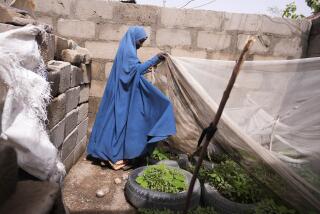Starving for funds
- Share via
THERE ARE TWO WAYS to get the images of starving African children -- those fly-blown living skeletons struggling to lift their heads on necks as thin as a bamboo stalk -- off your television screen. One is to flip to the SciFi Channel. The other is to put an international fund in place to ensure that food crises like the one in Niger never happen again.
Heart-rending pictures of dying children are not new. Our most memorable encounter was in the mid-1980s, when a famine in Ethiopia prompted international rock concerts to raise funds and awareness. But such images were prevalent before Live Aid, and they’ve been back periodically ever since.
It’s not that people aren’t generous when the nightly news confronts them head-on with the miseries of starvation. Since the crisis in Niger started getting widespread media coverage two weeks ago, donations have come pouring in, and aid workers say they’re much closer to getting the situation under control.
The trouble is, that kind of support only comes after the TV cameras have arrived -- and that only happens once children are starving to death by the score and what was initially a potential food shortage has turned into a humanitarian disaster. The human cost of that delay is apparent, but the economic cost is severe as well.
The United Nations has been appealing since November for aid to Niger, where a locust invasion and drought wiped out last year’s crops. Until recently, the international community largely ignored those cries. If the calls had been heeded last fall, Niger would have needed only food aid, which is relatively cheap. Now those starving children need extensive medical attention, which is very costly. Meanwhile, untold numbers of cattle that are vital to the region’s economic survival have died and will have to be replaced.
If the impending crisis had been addressed last fall, it would have cost $1 per person helped, according to the poverty-relief coalition Oxfam International. Now the cost is $80 per person.
And although aid is now pouring into Niger, the cameras haven’t yet arrived in neighboring countries, such as Mali, that are suffering nearly as much thanks to the same drought conditions. To many donors, these problems are invisible.
Aid officials have long known that this reactive system leads to needless death, suffering and expense. Now that world leaders have started paying more attention to Africa, there is a chance something might finally be done about it.
Next month, the U.N. will discuss a proposal by Secretary-General Kofi Annan to boost the U.N.’s emergency relief fund tenfold, to $500 million. Oxfam and the British government are pushing to raise it to $1 billion.
As it now stands, the U.N.’s Central Emergency Revolving Fund is a stopgap measure. When governments facing an impending emergency receive a pledge of aid from a wealthy donor, there is often a lengthy delay before the money arrives. Because they might need the funds right away to pay for emergency supplies such as seeds or food, they can apply for a loan from CERF to tide them over until the grant is paid.
Niger’s early appeals for aid got so little response that it had essentially no collateral. Oxfam wants CERF to give grants in addition to loans, and to do it regardless of whether donors have already agreed to chip in.
It will be a tough sell. Last month, the Group of 8 industrialized nations agreed to double aid to Africa to $50 billion a year by 2010. That means the world’s richest nations are already feeling donor fatigue, so they may not want to ante up yet more money for an emergency fund. Further, the blueprint spelling out how the extra G-8 money should be spent, a report from British Prime Minister Tony Blair’s Commission for Africa, doesn’t specifically address food crises, though it calls for a new fund to cover commodity shocks and natural disasters.
The G-8 theory is that the extra aid will pay for projects that boost agricultural productivity and raise enough people out of poverty that mass food shortages will become a thing of the past. That’s possible, but the process will take years, maybe decades. In the interim, a stronger U.N. emergency fund could help save starving children before they appear on our TV screens.
More to Read
Sign up for Essential California
The most important California stories and recommendations in your inbox every morning.
You may occasionally receive promotional content from the Los Angeles Times.










